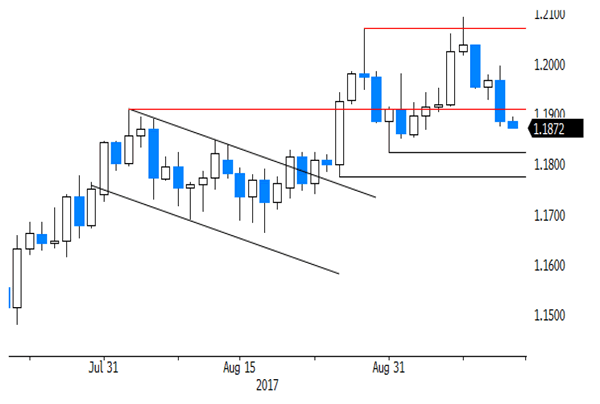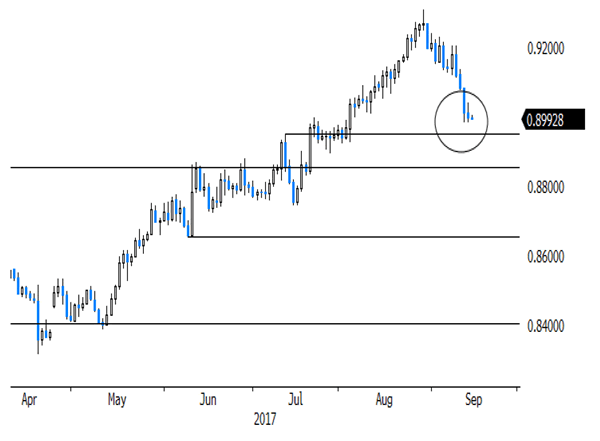Sunrise Market Commentary
- Rates: End of uptrend US Treasuries since start Summer?
The US Note future dropped below first technical support levels, suggesting an end to the uptrend which started at the start of July. US CPI will be published today and have the possibility to seal the deal. The market implied probability of a December Fed rate hike increased this week from 35% to 45%. - Currencies: EUR/USD and USD/JPY are near first technically relevant levels
The dollar succeeded a new up-leg yesterday even as (US) data were mixed, at best. EUR/USD (1.1823) and USD/JPY 110.67/95 are near first important technical support/resistance. The US CPI report might help to decide on break. The BoE meets today. A hawkish BoE statement might support the recent rebound of sterling
The Sunrise Headlines
- Three main US equity indices gained up to 0.2% yesterday, succeeding a simultaneous second straight all-time closing high. Asian stock markets are mixed overnight with Japan and China slightly underperforming.
- Paul Ryan, the top Republican in Congress, has sought to quell discontent in his own party over a lack of a concrete proposals on tax reform —legislative priority — by promising to unveil the outlines of a plan before the end of this month.
- US President Trump said he would stop a $1.3 bn China-backed bid for US-based chip maker Lattice Semiconductor, citing national-security risks. The order directed the companies to take all steps to drop the deal within 30 days.
- China posted its slowest growth in fixed-asset investment in nearly 18 years along with weaker-than-expected industrial output and retail sales, suggesting the economy may be starting to lose steam as lending costs rise.
- Australia’s labor market has demonstrated renewed strength, recording substantial gains in full-time employment (+40.1k) in particular; but under-employment remains stubbornly high. AUD/USD rose back above 0.80
- ECB Praet renewed his call for a "steady hand" in conducting the ECB’s ultra-easy monetary policy despite a positive growth outlook, striking a cautious note as the ECB prepares to decide whether and how to wind down its stimulus.
- Today’s calendar contains US CPI inflation and weekly jobless claims. ECB Weidmann and Mersch are scheduled to speak. The Bank of England holds a policy meeting and Ireland taps the bond market
Currencies: EUR/USD And USD/JPY Are Near First Technically Relevant Levels
USD maintains a good bid going into US CPI
The risk rebound slowed yesterday. Initially this was also the case for the rise in core yields and in the dollar. Eco data were few (US PPI) and close to expectations. Later in the US, yields started a new up-leg and so did the dollar. USD short-covering apparently had still some way to go. A new campaign of the Trump administration to reduce taxes maybe added to the USD positive sentiment. Contrary to what was the case earlier this week, USD/EUR this time outperformed USD/JPY. EUR/USD finished the session at 1.1885. USD/JPY ended the day at 110.49
Overnight, Asian equities are trading mixed. China and Japan mostly show modest losses. Other regional indices trade with a slightly positive bias. USD/JPY sits in the 110.50 area, nearing 110.67/95 resistance. EUR/USD (1.1875) holds near the correction low. Chinese data, including retail sales, investment and production printed weaker than expected. The yuan trades again slightly softer against the dollar. Strong Australian labour data pushed AUD/USD back above the psychological 0.80 barrier, but the move loses momentum.
The EMU eco calendar is again thin. US August CPI takes centre stage. Headline inflation is expected to rise 0.3% M/M and 1.8% Y/Y. The rise should be energyrelated. Core inflation is expected to ease from 1.7% Y/Y to 1.6%. The picture for US inflation remains soft if confirmed. That said, yesterday, mediocre US PPI didn’t prevent a further rise in US yields and in the dollar. If the BoE turns more hawkish on inflation, it might be slightly supportive for global core yields, with possible positive spill-over effects for the dollar. USD momentum clearly improved this week. USD/JPY and EUR/USD are near first technical significant resistance/support at respectively 110.67/95 and 1.1823. Is a break possible, with or without strong US data? Clearing these levels in a sustainable way would call of the USD negative momentum short-term.
Global context. The euro remained strong last week even as the ECB delayed communication on APP tapering till October and as Draghi kept a soft tone. Markets apparently took the view that ECB normalisation will come anyway. At the same time, the dollar lost further interest rate support as global uncertainty kept US yields on a downward trajectory.
Finally, the decline in US yields and of the dollar had gone far enough given recent US eco data, which remained fairly good. A technical correction occurred this week. The dollar in the first place needs an improvement in global sentiment and higher yields. US data might become noisy due to the impact of the hurricanes and can cloud the Fed’s outlook and complicate a USD rebound. In this context, we want more confirmation that the recent bottoming out process in US yields and in the dollar might be the start of more sustained USD gains. We keep a close eye on how the test of first important technical levels turns out (cf supra). A break of EUR/USD below 1.1823 would open the way to the 1.1662 correction low. We remain cautious on a sustained further upside break in USD/JPY

EUR/USD off recent top, nears first support at 1.1823.
EUR/GBP
BoE raising its inflation alert might support sterling
UK labour data failed to clarify the interest rate debate. The discrepancy between activity and wage data persisted. The unemployment rate dropped to 4.3%, the lowest level since 1975 and employment growth remained strong, but wage growth didn’t accelerate at all. At 2.1% Y/Y, real wages move further into negative territory. This combination leaves left the market wary on today’s BoE assessment and blocked the recent rebound of sterling. EUR/GBP closed the session at 0.8998 (from 0.9009). Cable finished the day at 1.3211 (from 1.3283) on overall USD strength.
The BoE decides on monetary policy today. Recent developments placed Carney and Co for a dilemma. The Bank will have to incorporate higher inflation in its assessment. At the same time, real wages remain negative and might weigh on spending and growth further down the road. A rate hike today is unlikely, but the bank will probably warn that it can’t ignore inflation. A 6-3 vote instead of a 7-2 vote is possible. If so, it might support a further sterling rebound.
From a technical point of view, EUR/GBP cleared 0.8854/80 resistance (top end June), opening the way for a protracted August rebound. The move was the result of euro strength. Simultaneously, UK price data were soft enough to keep the BoE side-lined. Recent price data amended this story. Medium term, we maintain a EUR/GBP buy-on-dips approach as we expect the combination of relative euro strength and sterling softness to persist. The 0.9415 ‘flash-crash spike’ is the next target on the charts. However, we let the current correction do its job, e.g. to the technical support in the 0.88/89 area, before selling sterling versus the euro.

EUR/GBP holds near 0.90 pivot ahead of BoE policy decision













